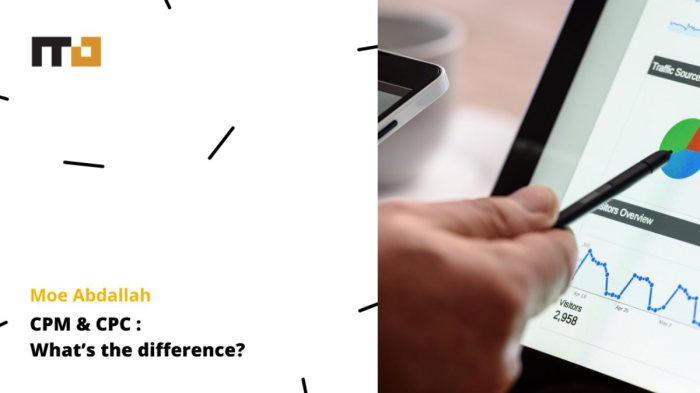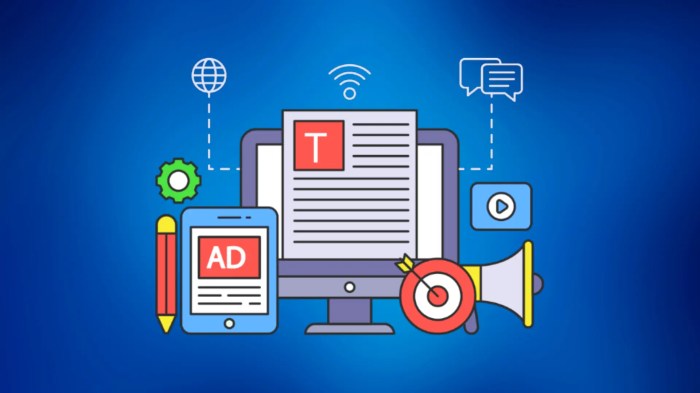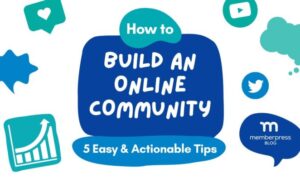Understanding CPC and CPM delves into the world of online advertising, breaking down the key concepts and strategies for optimal success in the digital realm. From defining CPC to exploring CPM, this topic promises to be a game-changer for your advertising campaigns.
Get ready to unlock the secrets to boosting your ROI and reaching your target audience with precision and finesse.
Understanding CPC and CPM
In the world of online advertising, two common pricing models are CPC (Cost Per Click) and CPM (Cost Per Mille). Let’s dive into what these terms mean and how they impact digital marketing strategies.
Define CPC (Cost Per Click)
CPC, or Cost Per Click, is a pricing model where advertisers pay a fee each time their ad is clicked on by a user. This means that the advertiser only pays when a user takes a specific action, which is clicking on the ad.
Explain CPM (Cost Per Mille) and Differences from CPC
On the other hand, CPM stands for Cost Per Mille, which means the cost per one thousand impressions of an ad. Unlike CPC, CPM focuses on the number of times an ad is displayed rather than the number of clicks it receives. Advertisers pay a set rate for every one thousand impressions of their ad.
Examples of When to Use CPC Over CPM
- When the goal is to drive traffic to a website through ad clicks.
- When the ad content is highly engaging and likely to result in clicks.
- When the target audience is more likely to interact with the ad through clicks rather than just seeing it.
Advantages and Disadvantages of CPC and CPM Models
- Advantages of CPC:
- Advertisers only pay when users engage with the ad.
- Easy to track and measure the effectiveness of the ad campaign.
- Directly correlates ad spend with user actions.
- Disadvantages of CPC:
- Competition can drive up the cost per click.
- No guarantee of conversions even with high click-through rates.
- Advantages of CPM:
- Good for increasing brand visibility and awareness.
- Cost-effective for reaching a large audience.
- Less dependent on user interaction for payment.
- Disadvantages of CPM:
- No guarantee of user engagement or action.
- Can be less effective for direct response campaigns.
Factors affecting CPC and CPM

When it comes to understanding CPC and CPM rates, there are several key factors that play a critical role in determining the pricing and effectiveness of online advertising campaigns.
Key Factors Influencing CPC Rates
One of the main factors that influence CPC rates is the competitiveness of the s being targeted in the advertising campaign. Highly competitive s will often result in higher CPC rates due to increased demand.
Additionally, the quality score of the ad and the relevance of the landing page to the ad can also impact CPC rates. Ads that are more relevant to the user’s search query tend to have lower CPC rates.
The overall performance of the ad, including the click-through rate (CTR) and conversion rate, can also affect CPC rates. Ads that perform well are often rewarded with lower CPC rates.
Bidding Process in CPC Advertising
- In CPC advertising, advertisers bid on s that are relevant to their target audience. The bidding process involves setting a maximum bid amount that the advertiser is willing to pay for a click on their ad.
- When a user searches for a that matches the advertiser’s bid, an auction is triggered, and the ad with the highest bid and best ad quality score wins the placement.
- The advertiser only pays when their ad is clicked on, making CPC advertising a cost-effective way to reach potential customers.
Impact of Ad Relevance on CPC and CPM Rates
Ad relevance plays a crucial role in determining both CPC and CPM rates. Ads that are highly relevant to the user’s search intent are more likely to receive clicks and conversions, leading to lower CPC rates.
Ad relevance is key to maximizing the effectiveness of online advertising campaigns and achieving a higher return on investment (ROI).
Effect of Targeting Options on CPC and CPM Pricing
- The targeting options chosen by advertisers can significantly impact CPC and CPM pricing. Targeting a specific audience with demographics, interests, or behaviors can result in higher engagement rates and lower CPC and CPM costs.
- Conversely, broad targeting options may lead to lower engagement rates and higher CPC and CPM costs, as the ads are being shown to a less relevant audience.
Strategies to optimize CPC and CPM: Understanding CPC And CPM
Optimizing CPC and CPM is crucial for the success of any advertising campaign. By implementing the right strategies, you can improve performance and maximize ROI. Here are some tips to help you achieve that:
Improving CPC Performance
- Target Specific s: Focus on long-tail s that are relevant to your target audience to attract more qualified leads.
- Optimize Ad Copy: Write compelling ad copy that resonates with your audience and encourages them to click on your ads.
- Landing Page Optimization: Ensure your landing pages are relevant to your ads and provide a seamless user experience to increase conversion rates.
- A/B Testing: Experiment with different ad variations to identify what works best and refine your strategy accordingly.
Maximizing CPM Efficiency and ROI, Understanding CPC and CPM
- Targeted Audience Segmentation: Divide your audience into specific segments based on demographics, interests, or behavior to deliver more personalized ads.
- Quality Content: Create high-quality content that engages users and encourages them to interact with your ads, increasing CPM rates.
- Ad Placement: Choose the right placement for your ads to reach your target audience effectively and maximize visibility.
- Frequency Capping: Limit the number of times a user sees your ad to avoid ad fatigue and improve CPM performance.
Importance of Tracking and Analyzing CPC and CPM Metrics
Tracking and analyzing CPC and CPM metrics is essential to measure the effectiveness of your advertising campaigns and make data-driven decisions. By monitoring key metrics such as click-through rates, conversion rates, and cost per acquisition, you can identify areas for improvement and optimize your campaigns for better results.
Successful CPC and CPM Optimization Techniques
- Use Retargeting: Target users who have previously interacted with your ads to increase conversion rates and ROI.
- Geo-Targeting: Tailor your ads to specific geographical locations to reach a more relevant audience and improve CPM efficiency.
- Mobile Optimization: Ensure your ads are optimized for mobile devices to capture the growing mobile audience and improve CPC performance.
- Monitor Competitors: Keep an eye on your competitors’ strategies and performance to stay ahead of the curve and adjust your own campaigns accordingly.
Case studies and examples

Case studies and examples provide valuable insights into how companies effectively utilize CPC and CPM for their marketing campaigns. Let’s explore some real-world scenarios to understand the practical applications of these advertising strategies.
Company A’s Successful CPC Campaign
Company A, an e-commerce retailer, launched a CPC campaign to promote their new product line. By targeting specific s related to their products and optimizing their ad copy, Company A was able to drive high-quality traffic to their website. The CPC model allowed them to pay only when users clicked on their ads, resulting in a cost-effective and efficient marketing strategy.
Successful CPM Campaign by Company B
Company B, a fashion brand, implemented a successful CPM campaign to increase brand awareness among their target audience. By displaying visually appealing banner ads on popular fashion websites, Company B was able to reach a large number of potential customers. The CPM model enabled them to pay for ad impressions, ensuring maximum exposure for their brand.
Comparison of CPC and CPM Campaign Results
- Company A’s CPC campaign focused on driving traffic and generating immediate clicks, resulting in a higher conversion rate compared to Company B’s CPM campaign, which aimed at brand visibility and exposure.
- While Company A achieved a higher click-through rate with their CPC campaign, Company B was successful in increasing brand recall and awareness through their CPM campaign.
- The comparison highlights the importance of choosing the right advertising model based on specific marketing goals and objectives.
Real-World Examples of CPC and CPM Usage
Many businesses across various industries have leveraged CPC and CPM for their advertising goals. For instance, a tech startup used CPC to target potential customers actively searching for software solutions, resulting in a significant increase in leads. Similarly, a food delivery service utilized CPM to reach a broader audience and increase brand recognition through targeted display ads on social media platforms.





